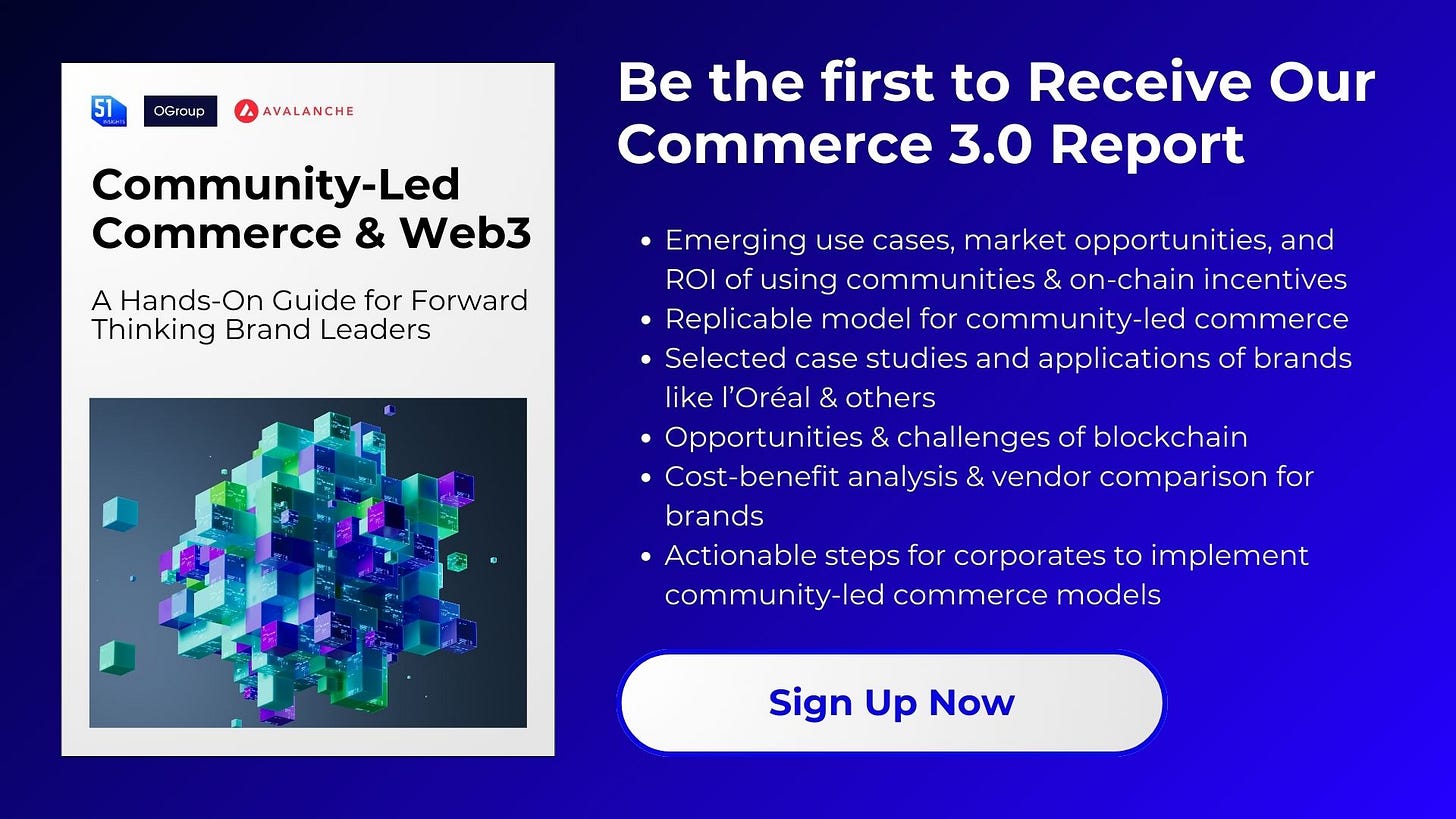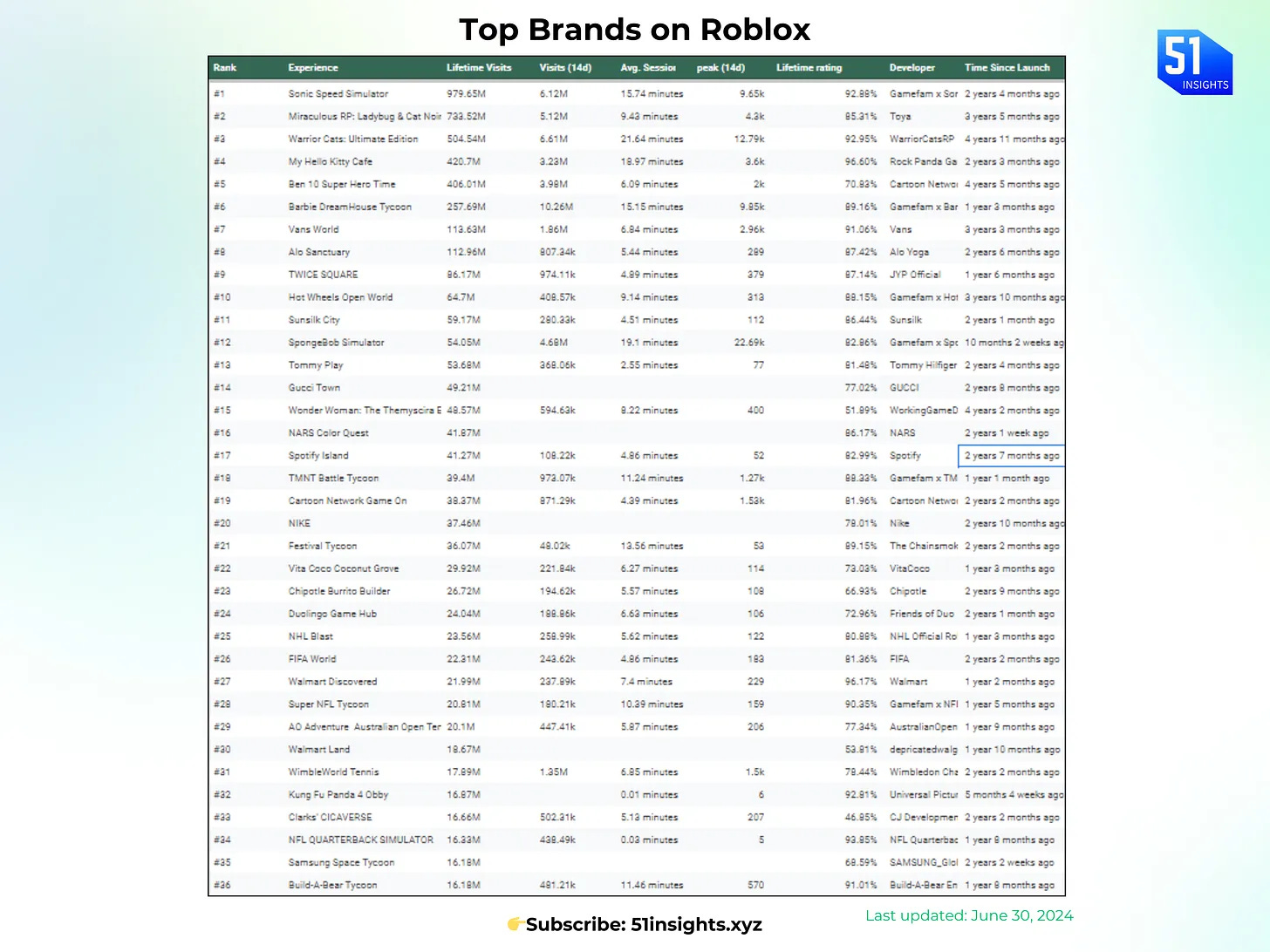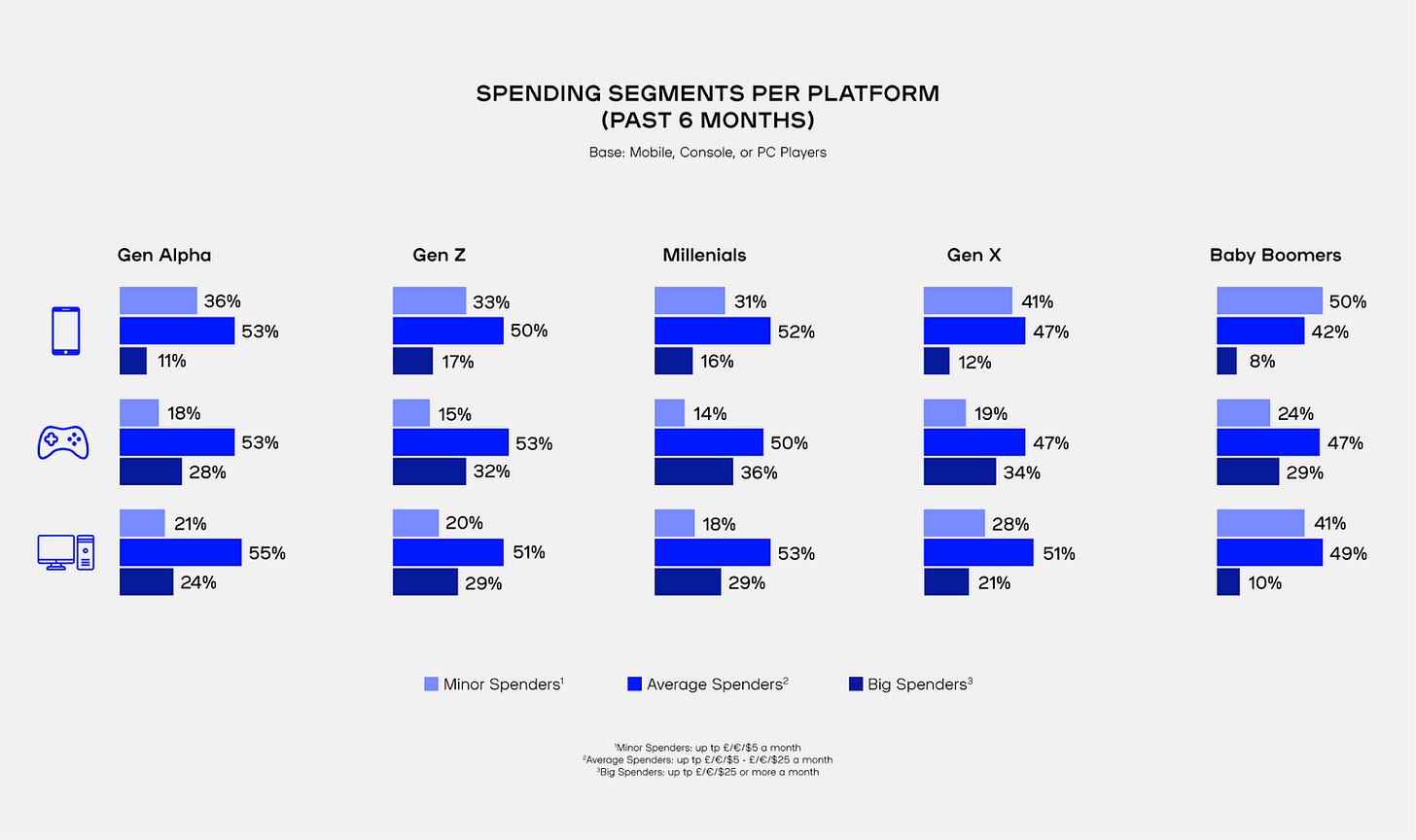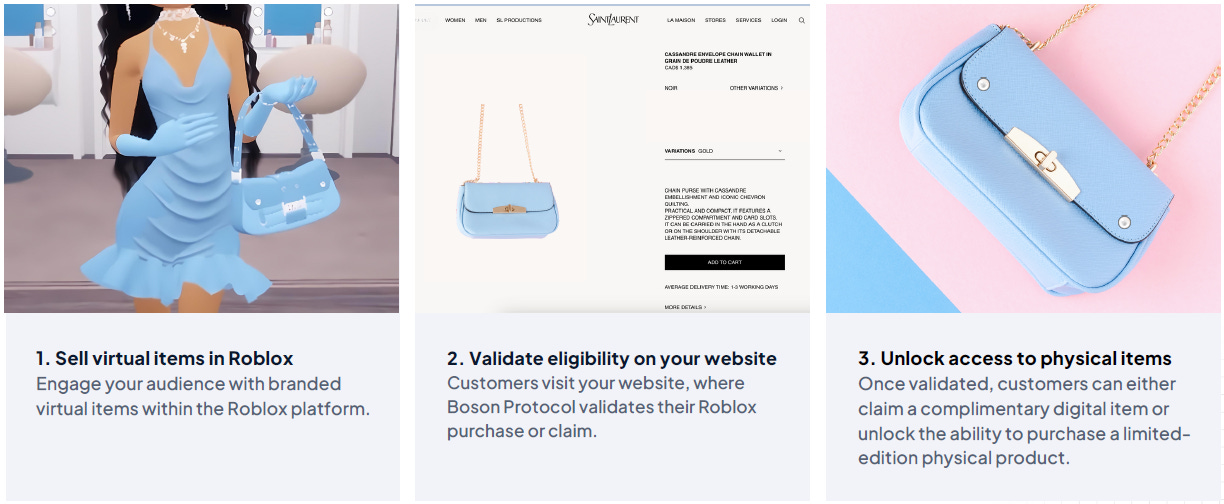Roblox: The Future of E-commerce in Virtual Worlds?
Hi, it’s Marc. ✌️
With over 79.5M daily active users, Roblox is a fast-growing platform for brands aiming to reach digital-first consumers.
For businesses, Roblox offers something rare—a young, engaged audience ready to interact, explore, and spend. And it’s working: in 2023, over 3.7B virtual transactions happened on Roblox, showing that Gen Z isn’t just playing; they’re buying.
Gen Z customers are already purchasing digital items, collectibles, and exclusive products within branded spaces on Roblox. Brands that harness this trend can transform visibility into direct sales.
What We’ll Cover:
Roblox: From Marketing to Monetization
Connecting Real-World Sales to Roblox
The Big Virtual-Commerce Opportunity for Brands
Boson V-Commerce: Bridging Real & Virtual Commerce on Roblox
Shopify vs V-Commerce vs Walmart
Takeaways for Brands
Let’s unpack this.
We work with leading brands like Avalanche, MoonPay, and Boson to co-publish enterprise-grade reports that amplify visibility, attract qualified leads, and elevate B2B conversion rates.
Roblox: From Marketing to Monetization
Roblox has evolved into a leading platform for user-generated content (UGC), enabling creators to monetize their designs. In 2023, players purchased over 1.6B UGC fashion items— a testament to the platform’s growing commercial potential.
But for brands, Roblox remains primarily a tool for engagement, not revenue.
The challenge: Creators take home just 30% of each sale, leaving brands with limited incentives to invest in UGC as a revenue driver. Compounding the issue, Roblox lacks standardized metrics to measure campaign ROI, making it tough to connect engagement to business outcomes.
For brands, the opportunity on Roblox is bigger than visibility—it’s about converting engagement into real revenue. To achieve that, brands need:
Virtual storefronts to enable direct sales.
Digital-physical bundles to tie virtual purchases to real-world goods.
Immersive shopping experiences that bring commerce into the platform’s ecosystem.
Today, brands are actively exploring ways to bridge commerce with the Roblox experience.
The next frontier? Making Roblox a true sales channel.
Connecting Real-World Sales to Roblox
Roblox is redefining online shopping by turning engagement into immersive commerce. Instead of browsing lists, users explore branded virtual worlds, forging deeper emotional connections with products and brands.
Why it’s important: Roblox enables users to experience products in a way traditional online shopping can’t match.
Gamified Shopping: Virtual stores and events transform shopping into play, creating stickier, more engaging experiences.
Virtual Meets Physical: Brands now link virtual items to real-world products, bridging the gap between online and offline commerce.
While brands have experimented with virtual storefronts, UGC campaigns, and in-platform activations, these efforts rarely connect back to real-world sales. Even if it does, brands cannot measure the ROI.
The gap? A seamless way to link virtual items in Roblox with physical products outside the platform.
Big moves in 2024: To bridge this gap, big names stepped up in 2024.
Walmart’s API: In April, Walmart launched a shopping experience where users could buy physical products directly through the Walmart Discovered experience.
Shopify Partnership: In September, Roblox announced Shopify as its first integrated commerce partner, making virtual-to-real transactions more accessible for brands.
Boson V-Commerce: In October, Boson Protocol introduced V-Commerce enabling brands to validate Roblox’s virtual item holders on the brands’ website bridging gaming and e-commerce.
📘 Be The First to Receive Our Web3 Consumer Report
Sign up now and be among the first 100 to receive it for free. 🚨
Punchline: Roblox is becoming more than a place to play; it’s a dynamic new sales channel where brands can create immersive shopping experiences that drive both engagement and revenue.
Brands are finding creative ways to turn Roblox’s massive audience into customers. Through virtual stores, gamified shopping, and immersive brand experiences, they’re making commerce a natural part of the platform.
Let’s break this down:
1. Virtual Stores
Virtual storefronts on Roblox offer brands a unique way to connect with younger audiences, combining interactive experiences with commerce. These stores enable brands to create immersive environments for their audiences on Roblox and generate revenue through the sales of virtual items.
Immersive Experiences: Customized virtual environments let users explore products in ways traditional online stores can’t match.
Consumer Insights: Tracking in-store user behavior provides valuable data to shape future strategies.
Example: Nikeland
Nike launched Nikeland on Roblox— a virtual world inspired by its headquarters—to connect with younger audiences in an interactive way.
Gamified Engagement: Users participate in mini-games and challenges, earning exclusive digital Nike gear for their avatars—a strategy that keeps them engaged and reinforces Nike’s brand presence.
Building Real-World Buzz: Limited-edition virtual items in Nikeland generate excitement, boosting awareness for Nike’s physical collections.
The challenge: Despite the buzz, these activations lack the ability to track ROI or access conversion data, leaving brands without clear insights into the impact on physical sales.
2. Gamification
Roblox is more than a gaming platform—it’s a thriving virtual universe where gamification is at the core of user engagement. Brands are using gamification in their virtual stores to enhance the shopping experience and make physical shopping more engaging.
Example: Chipotle Burrito Builder
Chipotle launched the Burrito Builder on Roblox, where players could create virtual burritos and earn Burrito Bucks, redeemable for real food on Chipotle’s platform.
Immediate Impact: The campaign attracted over 4M players in its first week, with demand so high that Chipotle’s site crashed for 73 hours.
Leveraging Momentum: Chipotle capitalized on the buzz by introducing a new menu item, amplifying brand impressions and engagement.
The challenge: While the campaign successfully drove signups and increased orders, tracking ROI remains a challenge. Players had to leave Roblox to place real orders, making direct sales tracking difficult.
For an in-depth look, check out our dataset of 100+ top brands on Roblox and their immersive commerce activations. Subscribe to PRO to get free access to all the data 👇
The Big Virtual-Commerce Opportunity for Brands
Roblox is emerging as the ultimate platform for brands to engage with Gen Z and Gen Alpha. With 51M daily users under 16, the potential to drive sales through immersive experiences is immense.
Gen Z and Gen Alpha aren’t just gaming—they’re spending. 52% of Gen Z gamers spend money regularly on games, outpacing the general online population. And 18% of Gen Z are willing to spend $50–$100 on virtual items each month.
By the data: In 2023, Roblox players purchased over 1.6B fashion items and accessories, and creators earned $741M from user-generated content (UGC).
The top 10 Roblox creators earned an average of $30M in Q2 2024 LTM.
It means: On average, a Roblox player makes 10 virtual purchases in a year. And, creators generate an average of $0.46 with the sale of 1 virtual item, based on the cashed out amount.
With the right e-commerce integrations or tools for validation, brands can convert these interactions into real revenue.
Why should brands act now? New technology is changing how brands can interact with new consumers. It is evident that brands can leverage the presence of Gen Z and Gen Alpha on Roblox. With an e-commerce bridge, the experimentation will convert into revenue streams and clear ROIs.
Here’s why brands should capitalize on Roblox’s platform to connect immersive marketing with e-commerce:
Revenue Potential: Gamified campaigns can redirect users from Roblox to e-commerce platforms, but without integration/ bridge, ROI remains elusive.
Access to Millions: Roblox’s 80M+ daily users are highly engaged. E-commerce bridging integration helps bring them directly to your website, making campaigns more targeted.
Enhanced Accessibility: Seamlessly connecting physical product sales with the virtual world creates a frictionless experience for consumers.
Audience Identification: Analyzing virtual item purchases on Roblox gives brands insights into consumer preferences, enabling targeted, personalized marketing.
Data-Driven Insights: E-commerce integration provides valuable data to refine strategies and understand consumer behavior.
The bigger question is: what are the ways to do this?
1. Shopify Enters Roblox
Roblox partnered with Shopify to allow creators to sell physical goods directly within the game using Shopify’s checkout, with a full rollout planned for 2025. This integration will enable brands to sell physical items seamlessly in Roblox.
With fashion as Shopify’s largest segment, this partnership opens up new opportunities for small and medium businesses to reach customers through immersive Roblox experiences.
2. Walmart Integrates E-Commerce
Roblox integrated e-commerce features as a virtual storefront showcasing digital twins of physical items sold at Walmart, available for users to purchase with direct delivery to their homes.
Example: E.L.F Beauty’s Elf Up
E.l.f. launched a kiosk on Roblox, using Walmart’s APIs to let U.S. users 13+ buy select cruelty-free products. Each purchase came with a “virtual twin” for use in the game, adding exclusive items to player experiences.
Purpose-Driven: Reinforcing its cruelty-free mission, E.l.f. is donated $50K to the Humane Society.
Strategic Growth: E.l.f.’s marketing approach drove a 77% increase in net sales for fiscal 2024.
Walmart’s API lets brands track essential data points to measure ROI effectively. Combined with Roblox’s customer data, brands can identify high-value segments and tailor future campaigns.
The challenge: Walmart APIs aren’t directly accessible on Roblox. To launch its campaign, E.L.F. collaborated with both Roblox and Walmart.
3. Boson V-Commerce
Launched by Boson Protocol, V-Commerce enables brands to connect Roblox with physical product sales and bring Roblox users to their website to make the purchase. It is helping brands bridge the gap between gaming, and e-commerce with seamless integration and low-code solutions.
There is a catch. Both Shopify integration and Walmart API open new doors for brands, but they also come with the same issue: revenue share. And, this brings brands back to square one. Just like Roblox takes a cut of creator earnings, Shopify and Walmart will do the same, plus charge integration fees.
With Walmart, brands need partnerships with both Walmart and Roblox, adding complexity. Shopify’s integration, set for 2025, is still unclear. As a result, Roblox may remain a platform for exposure rather than long-term revenue generation.
The impact: Brands will not just bear revenue sharing with these big companies cutting into profits, but also any additional costs associated with integration and campaign. They also have to follow Roblox’s rules, limiting their ability to fully customize the experience and data access. Moreover, with more intermediaries like Walmart, the integration has multiple layers of complexity. This could lead to a slow implementation process with increased operation friction.
The solution: V-Commerce bridges the gap, not just with accessibility but with making the revenue generation real through Roblox.
The core challenge for brands on Roblox isn't just reaching younger consumers—it's navigating the platform’s revenue-sharing model.
Let us look further into V-Commerce and how brands can implement it to boost the ROI of their Roblox activations.
Boson Virtual-Commerce
Boson V-Commerce—virtual commerce—allows brands to bypass platform fees and capture revenue by targeting Roblox’s audiences. It offers a simple solution to brands as a bridge between Roblox and their e-commerce platform, eliminating the operational complexity of models like Walmart’s API.
How Does It Work?
V-Commerce bridges Roblox and the brand’s e-commerce platform and hence creates a continuous customer journey from the virtual world to the physical world.
Example: Say, a brand launches “X” virtual item on Roblox and allows these holders to claim a 50% discount on physical purchase of that item. In this case, the user journey will be:
User A buys “X” on Roblox.
Now, they visit the brand’s website and verify the ownership.
After verification, they can claim a 50% discount and purchase the physical item.
The verification of the ownership of the virtual item on the Roblox will be done at the backend using Boson V-Commerce.
Key Features of V-Commerce
No intermediaries: It eliminates the multi-partner systems and makes sales direct to consumers, increasing profitability and operational efficiency.
Easy integration: V-Commerce offers a low-code solution that allows brands to target a diverse audience segment based on their ownership of Roblox's virtual items.
Full control: Brands can tailor their campaign associated with Roblox’s experience without being restricted by third-party guidelines and own physical product sales data end-to-end.
Roblox as a sales channel: V-Commerce allows brands to expand their sales channel to Roblox by connecting their Roblox activation with direct purchases via the brand’s website.
How Brands Can Utilize V-Commerce?
Boson V-Commerce allows brands to get more from Roblox’s virtual storefronts. With this solution, brands can easily unlock the full potential of virtual engagement on platforms like Roblox while driving tangible sales on their own websites. Here are a few ways that brands can explore:
Reward Roblox Engagement
Brands can create a custom campaign including Roblox activation with exclusive digital items tied to real-world purchases. Such campaigns can also be enhanced with benefits like limited-edition access or early access to new collections.
For instance, users who buy a virtual item in Roblox can unlock discounts or exclusive offers for physical products on the brand's website. In this way, they can reach out to Roblox’s audience offering them virtual experiences tied with real-world benefits.
Cross-Target Virtual Item Owners
With Boson V-Commerce, brands can target users who own virtual items from other brands within Roblox, expanding their reach to broader and more engaged audiences.
For instance, a yoga clothing company can target people who bought Alo Yoga’s virtual item collection on Roblox and invite them to shop on their website with additional benefits.
Gamified Loyalty Programs
V-Commerce helps brands to utilise Roblox for more than one-off campaigns. Brands can transform virtual achievements into real-world rewards, creating a seamless connection between digital engagement and long-term advocacy.
For instance, users who collect multiple virtual items could unlock exclusive perks, such as VIP access to limited-edition products or higher-tier loyalty benefits. This gamified approach encourages repeat interactions and strengthens emotional ties to the brand.
Custom Collaborative Campaigns
Boson V-Commerce enables brands to team up for unique, engaging campaigns that span across virtual and physical worlds.
For instance, a brand with no digital follower base wants to debut on Roblox. They can strategically team up with another brand with a good presence online and active engagement on Roblox. They can collaborate on a Roblox activation, where purchasing a virtual item from one unlocks exclusive discounts or rewards from the other.
Take it a step further—a fashion brand could partner with a gaming accessory brand to offer virtual items that seamlessly unlock physical rewards across both their websites. The result? A mutually beneficial strategy that engages audiences while driving real-world sales.
“Boson V-commerce empowers brands to turn Roblox virtual purchases into real-world sales, by enabling UGC to unlock sales of physical products on the brands own website. Driving physical product sales from digital investments while engaging more directly with your customers.”
– Justin Banon, Co-Founder, Boson Protocol
Boson V-Commerce enables brands to move beyond traditional programs, offering immersive, multi-channel experiences that keep customers engaged—and coming back.
Boson vs. Shopify vs. Walmart: The Better Choice for Roblox Integration?
Right now, there are only 2 ways to connect Roblox with e-commerce platforms– Boson’s V-Commerce and Walmart API. Roblox’s Shopify integration is yet to launch, but is not restricted to Walmart products.
Let's break down why Boson's V-Commerce might be a more attractive option for business leaders than Shopify's Roblox integration:
Depth of Integration:
Shopify: Focuses on facilitating transactions. It's like embedding a Shopify checkout within Roblox. You can buy a physical item, but the experience largely ends there.
Boson: Aims for deeper integration with the Roblox experience bringing consumers to the brand’s website. Imagine a quest in a Roblox game where completing a challenge unlocks a discount code for a real-world item, or where owning a specific virtual item grants access to exclusive physical merchandise. Boson's infrastructure is designed to weave these connections into the game's fabric, making commerce a more natural part of the experience.
True "Phygital" Products:
Shopify: While facilitating the purchase of physical goods inspired by Roblox, it's not necessarily creating truly integrated "phygital" products.
Boson: Potentially enables the creation of products that exist both in the virtual and physical worlds. Imagine a virtual sneaker in Roblox that unlocks a discount on a limited-edition physical version, or a virtual concert ticket that grants access to exclusive behind-the-scenes content in the real world.
Own your data:
Shopify: Brands will operate within Shopify's ecosystem, relying on its analytics and data-sharing policies. This often limits access to granular data about buyer behaviour and platform-specific insights.
Boson: Brands retain full ownership of their customer data. By driving users to their websites, brands can collect, analyze, and leverage detailed insights to personalize experiences, optimize campaigns, and build long-term loyalty—all without being confined by third-party restrictions.
Cross-Targeting Capabilities:
Shopify: Focused on the individual transaction and lacks tools for cross-targeting users across different experiences on Roblox.
Boson: Unlocks opportunities for brands to engage audiences based on their ownership of virtual items, even if those items belong to other brands. This opens doors for collaborations, cross-promotions, and targeting digital-native consumers with tailored offers that align with their interests.
Imagine sharing a donut with two fat kittens. This is how the picture looks with Shopify or Walmart's e-commerce integration.
With Boson V-Commerce, brands have complete control. From defining campaign rules to tailoring user experiences, everything stays aligned with the brand’s identity. More importantly, hosting these campaigns on their own websites means brands retain valuable customer data, enabling them to build deeper connections and refine strategies over time.
Boson V-Commerce isn’t just about selling—it’s also about: engaging, rewarding and converting.
Takeaways for Brands
Roblox offers brands an unparalleled opportunity to reach a highly engaged audience. But the key to success isn’t just showing up; it’s about creating an immersive experience that stands out—a challenge that requires real effort and strategy.
The Challenge:
While Roblox has millions of creators, earnings are highly concentrated among a few top sellers. With a minimum cash-out threshold of 30,000 Robux (~$105), only 16,500 out of Roblox’s 5 million creators were eligible to cash out in 2023. For brands, this means that simply selling virtual items won’t be enough to generate meaningful revenue. A well-designed, engaging experience is essential to drive real results.
The Opportunity:
Brands that go beyond traditional sales tactics are seeing success on Roblox. Building immersive, branded experiences—like interactive in-game stores, influencer partnerships, and loyalty programs that link in-game rewards to real-world products—helps brands connect authentically and drive deeper engagement. These strategies make brand interactions feel natural and can turn casual users into loyal customers.
Example to Watch:
Alo Yoga’s “Alo Sanctuary” shows that even with millions of visits, sustained engagement requires a well-designed virtual experience. Despite high foot traffic, the activation saw limited repeat engagement, with only about 10K users marking items as favourites.
We recently hosted a live session with Dubit, who recently worked with Starbucks for their Roblox activation.
How to Start:
Know your entrance strategy:
Three levels of entry:
UGC items - quick, low cost
Game integrations/pop-ups - mid-tier, 2-4 week setup
Full game builds - low six figures, 3-4 months with ~8-person team
Pro tip: Budget for 12-24 months of live operations to sustain engagement.
Leverage Data for Impactful Campaigns
Use engagement data from Roblox to design products and experiences that align with user behaviour. Tools like V-Commerce can allow you to track metrics for engagement, ROI, and sales, enabling data-driven campaign improvements.Commit to a Long-Term Strategy
One-off campaigns won’t build lasting brand value. Develop a sustained strategy on Roblox, and diversify across digital platforms for ongoing engagement and customer loyalty. Long-term efforts will build stronger lifetime value and deepen customer relationships. And, what could be better than having it all on your website?
Roblox is no longer just about play—it’s becoming a powerful new sales channel for brands to drive engagement, revenue, and long-term customer loyalty.
And the bigger question is: what is going to be your strategy in this virtual commerce space?
That’s it for now.
Talk soon,
Marc & Team
PS: If you’re interested in working with Boson Protocol, reach out here.
___
This article is published in collaboration with Boson Protocol. As the author, we maintain full editorial integrity and the views and insights expressed are my own, ensuring the content remains unbiased and authentic.
PS: Before you go, here’s how our industry OGs, vast network, research team & 50k+ B2B audience help you:
Co-publish enterprise-grade reports with us, driving traffic and boosting B2B outbound conversion rates.
Execute a multi-channel growth campaign that delivers better results than anything else in Web3's consumer space.
More feedback? Reply to this email.

















